 The other day, as we prepared our driveway for new gravel, I lamented to my partner about how movies have stripped the magic from the natural world.
The other day, as we prepared our driveway for new gravel, I lamented to my partner about how movies have stripped the magic from the natural world.
I want to rephrase and make it clear that movies have not actually stripped Earth of her magic—no one can do that.
However, we as humans have been stripped of, or largely lost, our ability to see the magic of nature and often misunderstand it—even when it is right in front of us and under our feet.
Movies and television exaggerate things for people, in order to make up for the senses that are lacking when only watching a screen. Events are condensed into sequences that show the key moments of a whole epic in a limited amount of time.
Art imitates life, and then life imitates art. They feed off one another and then evolve together.
Movies are seeking to display reality, but they simply cannot. People are led to having unrealistic expectations of what they will observe in the world around them. Expecting the grandiosity from the theatrical world, they feel disappointed when they are met with a nature that does not follow the rules of a Hollywood script or timeline.
Nature knows not these limited time schedules, deadlines, or concepts of boredom from her audience. Her magic takes place regardless of anyone watching. Some magical moments take only seconds to transpire after the preparations have been undergoing for years or decades.
Some people intentionally spend time observing the slow movements of nature, the purposeful intention unfolding season after season, year after year, cycle after cycle.
My partner grew up in rural Arkansas on a communal farm in a town that had a smaller population than my graduating class in one of our country’s largest cities, Phoenix, Arizona.
One of the reasons I fell in love with him is his green thumb and his drive to nurture nature and plant things wherever he goes.
My family’s garden bed (where we live now) was a sad, single bed of dirt, and the entire yard has been—and continues to be— transformed into permaculture gardens in only two years and in conjunction with helping to caretake for the elders in my family.
The more time I spend outside with him in the garden, planting and observing in conjunction with reading books from scientists who study plants, the more the magic of the natural world is opening to me. As a person who grew up experiencing the world through screens, I am seeing life in new ways that I never had access to.
Watching tiny seed sprout leaves and the slow-motion explosion of a plant over a series of several days, and then eventually getting to eat a delicious treat at the end is magic I truly underestimated by only observing others do it from a distance and not experiencing it for myself.
Watching a mystery plant that I insisted was a blackberry (and my partner kept calling it a grape), flower and develop its fruit to reveal the tiny forms of little green blackberries.
Turning a huge pile of wood chips, food scraps, and horse manure into nutritious ready-to-use compost for our plants in less than a month.
My daughter devouring a red, ripe tomato from the garden bed of which she crawled around in—after her daddy had made it—before there was fresh soil in it.
Seeing a hummingbird hover to drink from the fountain that, until recently, laid dilapidating on the ground. My partner created the foundation for it, with the help of my father, and set up the electrical work with the help of his father; it became a family community project and the heart of our garden space.
These are the magical moments that cultivating this garden has created for our family. Learning about and taking care of plants has taught me about myself and others, as well as the world, in a way that I’d never realized.
I learned from Suzanne Simard’s TEDTalk that in forests trees form networks with the mycelia and roots under the soil. I learned from the book Thus Spoke the Plant by Monica Gagliano that plants can learn and communicate with each other in other ways like chemical vapor and vibration.
I also learned that some plant species are antagonistic to each other, and prevent the plants from growing well when planted together, whereas other plants are companion plants and thrive better together than when planted alone.
In the book Braiding Sweetgrass by Robin Wall Kimmerer, I learned about a Native American planting technique called the Three Sisters Garden. Squash, beans, and corn are planted together in a companionship group to provide each other benefits. The corn stalk provides a structure for the bean to climb up, and the bean provides sun protection for the corn stock.
The big squash leaves protect the sprouts of the bean and corn when they first germinate. Other types of companion planting work to provide natural pest control so that we do not need to use chemicals that are harmful to everything it comes in contact with.
I wish that every school featured a permaculture food forest and gardens that the children helped design for a local food source and for a diverse and naturally soothing environment.
It has been scientifically proven that spending time in green spaces is good for our mental health, as discussed in the book The Nature Fix by Florence Williams.
Personally, I wish to homeschool my children and have lost much faith in the current school structures. If changes like these were implemented because parents and educators requested it, I think it would greatly affect all the students who were able to participate in such programs. I believe that entire curriculums and schools could be designed around the growing and cultivation of plants—especially edible ones—which is arguably is one of the most important skills to fill the most basic of needs that humans have.
Growing plants is a science, these are real-life experiments unfolding in front of the children, the end results in literal fruits of their labor. Math concepts taught with ratios of ingredients for creating compost, determining planting depths, and spacing plants properly, designing beds allow for the determination of surface area and volume.
Chemistry is taught in planting because compounds break down into basic elements as they decompose, and elements are fixed into the soil by particular plants as they grow. Sacred geometry can be studied in the structures of plants as they grow. Language arts, the ability to read and write and transfer knowledge is also covered because we have to learn about each plant in its biodiversity to make the most use of its natural abilities and to make sure the plant has what it needs to thrive, and then documenting our success and failures and making adaptations based on our observations.
Just like a garden, our children are unique and their garden spaces will be just as unique as they are. With beginner’s luck and creativity, they may even discover things about natural systems that will teach and inform the adults. It will provide the creative space needed for adaptation and working with the natural world that is desperately needed by humanity right now if we are going to slow the speed of climate disruption.
It is time to work together with nature, rather than against it.
It’s time to wake up from the dreamland Hollywood has cast over us, and reconnect and remember the magic of the world right here at our feet.
When we work with nature, by studying nature and imitating her patterns, we can create true abundance for ourselves and for future generations.
We can rebuild the earth from the ground (soil) up—from the children up.
We need to teach children about permaculture—about caring for the earth and for her people—and returning their surplus to the system to create abundance for all.
Raise a generation who deeply knows and cares for the earth, and they will preserve it for future generations.






Read 1 comment and reply